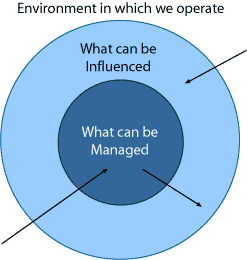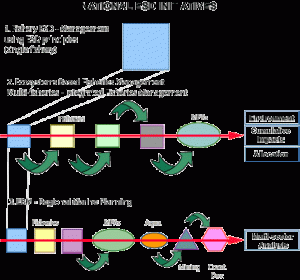ESD, Ecosystem Based Management (EBM) and other related systems
ESD, Ecosystem Based Management (EBM) and other related systems
Background
There has been a high level of confusion in the use of terms such as Ecologically Sustainable Development (ESD), Ecosystem Based Management (EBM), Ecosystem Based Fishery Management (EBFM), Integrated Oceans Management (IOM) and Environmental Management Systems (EMS). As part of the ESD workshop held in April 2004, these specific terms, and the general problem of dealing with different terminology amongst groups and countries, were discussed by the ESD Reference Group. It was hoped that the outcomes of these discussions would minimise the level of confusion in the future, at least within the stakeholders operating within the marine related sectors in Australia. The following definitions have now been agreed by the Australian Fisheries Management Forum [1] and the Marine & Coastal Committee of the Natural Resources Management Standing Committee [2].
Relationships between ESD, EBM, EBFM, IOM and EMS
The ESD Reference Group determined that ESD was the overall goal and that the other terms (eg EBFM) described strategies that were being used to work towards the goal of ESD. In any assessment using an ESD framework, all relevant environmental issues, social and economic outcomes and governance issues can be covered, the main difference is the scope of the issues that are being addressed.
The primary factor affecting the scope is that for any sector (be it an individual, an industry, an agency, or even a government) there are issues that can be managed directly, issues that can be influenced, plus there is the environment within which you operate that can’t be controlled (Fig. 1). Thus, the main difference between the implementation of these different terms is the scope of issues that are covered.
Thus, these terms form a cascade or hierarchy that all work within an overall ESD framework (see also Fig. 2), with each level providing the building bocks for the next level (Table 1).
Industry EMS ► Fishery ESD ► EBFM ► EBM ► IOM ► ESD
At the lowest level are the Environmental Management Systems (EMS). An EMS can be developed to describe how an individual business or a fishery is attempting to meet ESD principles.
(1) An Industry level EMS deals with the management of a corporate group within a fishery or fishing area. They describe how an individual/company/ group will meet some, or all, of their requirements as dictated by the relevant management objectives/community expectations. A relevant example is the Pumistone Passage Fishing Initiative.
(2) A Fishery ‘ESD’ Report deals with the management of a fishery and describes how a fisheries agency is implementing their management plan [3] to achieve ESD objectives. Thus each of the “ESD” reports being generated for export fisheries to meet EPBC requirements are actually an EMS with a specific example being the ESD report for the Shark Bay Prawn Fishery.
(3) Ecosystem Based Fishery Management (EBFM) deals with the aggregate management of all fisheries related activities within an ecosystem or bioregion. This recognises that any fisheries agency can only directly manage “fisheries related” activities (i.e. what is covered by their Act/Legislation).
To undertake EBFM requires the integrated management of all fishing activities within a region, not just single fisheries, to ensure that the cumulative impacts and the allocation amongst sectors are being adequately managed to assist in achieving ESD for the region. (No completed examples of this yet available)
(4) Ecosystem Based Management (EBM) deals with the aggregate management of all sectors (fishing, shipping, tourism mining etc) operating within a single bioregion to achieve ESD outcomes.
(5) Integrated Oceans Management (IOM) not only deals with all sectors but covers a series of adjacent marine bioregions. An example is the SE Marine Plan being developed by NOO.
(6) Full ‘ESD’ would require a completed IOM strategy that is linked/integrated with a similarly comprehensive strategy for any adjacent terrestrial regions. These could be further expanded from a region to national and international scale ESD assessments; the latter would cover the entire planet.
General
The ESD Reference Group recognised that it will be impossible to stop the development of new terms to encompass principles/issues that are already covered by these existing terms. The general principle is that in all reports/publications the use of any term should be defined, or refer to a readily available source. For example when using the term ESD, the definition used should refer back to the 1992 National Strategy.
Figure 1 – Scope of influence. The effective size of each of the circles (what can be managed and what can be influenced) increases as you move you’re analyses from the individual, to the fishery, to the agency, to a single government to multi-governments.

Figure 2 Summary of relationship between the current ESD Subprogram Initiatives

Table 1 Outline of the Relationship between the various terms
| Category of Assessment | Seeks To Manage | Current Reporting Examples |
|---|---|---|
| Industry sector EMS | Some/all Impacts [4] of an individual/group | Pumistone Passage |
| Fishery ESD | All fishery related impacts | ESD/EPBC Reports |
| Ecosystem based Fishery Management (EBFM) | All fishing related impacts within a bioregion | None Yet |
| Ecosystem Based Management (EBM) | All impacts occurring within a marine bioregion | None yet |
| Integrated Oceans Management (IOM) | As above for a series of marine bioregions | SE Regional Marine Plan |
| Regional ESD | All terrestrial, oceanic and atmospheric impacts in a region | None Yet |
| National ESD | As above for a country | State of Environment |
| International ESD | As above for the world | UN Protocols |
[1] – Which includes the heads of each fisheries agency in Australia
[2] – This includes the heads of both fisheries and marine conservation agencies in Australia
[3] – A Management Plan can be a formal/legal document or just the set of arrangements used to manage the fishery
[4] – For this table, impacts include both positive and negative effects and covers environmental, social and economic issues.

